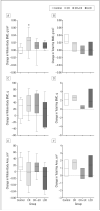Calorie restriction and bone health in young, overweight individuals
- PMID: 18809812
- PMCID: PMC2748345
- DOI: 10.1001/archinte.168.17.1859
Calorie restriction and bone health in young, overweight individuals
Abstract
Background: Calorie restriction (CR) is promoted to increase longevity, yet this regimen could lead to bone loss and fracture and therefore affect quality of life.
Methods: Forty-six individuals were randomized to 4 groups for 6 months: (1) healthy diet (control group); (2) 25% CR from baseline energy requirements (CR group); (3) 25% energy deficit by a combination of CR and increased aerobic exercise (CR + EX group); and (4) low-calorie diet (890 kcal/d; goal, 15% weight loss) followed by weight maintenance (LCD group). Bone mineral density (total body and hip by dual-energy x-ray absorptiometry) and serum bone markers (bone-specific alkaline phosphatase, osteocalcin, cross-linked C-telopeptide of type I collagen, and cross-linked N-telopeptide of type I collagen) were measured at baseline and after 6 months.
Results: Mean +/- SE body weight was reduced by -1.0% +/- 1.1% (control), -10.4% +/- 0.9% (CR), -10.0% +/- 0.8% (CR + EX), and -13.9% +/- 0.7% (LCD). Compared with the control group, none of the groups showed any change in bone mineral density for total body or hip. Bone resorption by serum cross-linked C-telopeptide of type I collagen was increased in all 3 intervention groups, with the largest change observed in the LCD group (CR, 23% +/- 10%; CR + EX, 22% +/- 9%; and LCD, 74% +/- 16% vs control, 4% +/- 10%). Serum levels of cross-linked N-telopeptide of type I collagen were also increased in the LCD group. With regard to bone formation, bone alkaline phosphatase levels were decreased in the CR group (-23% +/- 10%) but were unchanged in the CR + EX, LCD, and control groups.
Conclusions: Moderate CR, with or without exercise, that preserves calcium intake for 6 months leads to large changes in body composition without significant bone loss in young adults. Longer studies with assessments of bone architecture are needed to confirm that CR nutrient-dense diets have no deleterious effect on bone health.
Trial registration: clinicaltrials.gov Identifier: NCT00099151.
Figures



Similar articles
-
Metabolic and behavioral compensations in response to caloric restriction: implications for the maintenance of weight loss.PLoS One. 2009;4(2):e4377. doi: 10.1371/journal.pone.0004377. Epub 2009 Feb 9. PLoS One. 2009. PMID: 19198647 Free PMC article. Clinical Trial.
-
Effect of 6-month calorie restriction on biomarkers of longevity, metabolic adaptation, and oxidative stress in overweight individuals: a randomized controlled trial.JAMA. 2006 Apr 5;295(13):1539-48. doi: 10.1001/jama.295.13.1539. JAMA. 2006. PMID: 16595757 Free PMC article. Clinical Trial.
-
Reduced bone mineral density is not associated with significantly reduced bone quality in men and women practicing long-term calorie restriction with adequate nutrition.Aging Cell. 2011 Feb;10(1):96-102. doi: 10.1111/j.1474-9726.2010.00643.x. Epub 2010 Nov 15. Aging Cell. 2011. PMID: 20969721 Free PMC article.
-
Bone mineral density response to caloric restriction-induced weight loss or exercise-induced weight loss: a randomized controlled trial.Arch Intern Med. 2006 Dec 11-25;166(22):2502-10. doi: 10.1001/archinte.166.22.2502. Arch Intern Med. 2006. PMID: 17159017 Clinical Trial.
-
The effect of caloric restriction interventions on growth hormone secretion in nonobese men and women.Aging Cell. 2010 Feb;9(1):32-9. doi: 10.1111/j.1474-9726.2009.00530.x. Epub 2009 Oct 30. Aging Cell. 2010. PMID: 19878147 Free PMC article. Clinical Trial.
Cited by
-
Improved nutritional status and bone health after diet-induced weight loss in sedentary osteoarthritis patients: a prospective cohort study.Eur J Clin Nutr. 2012 Apr;66(4):504-9. doi: 10.1038/ejcn.2011.201. Epub 2011 Dec 21. Eur J Clin Nutr. 2012. PMID: 22190136 Free PMC article. Clinical Trial.
-
Weight loss and bone mineral density.Curr Opin Endocrinol Diabetes Obes. 2014 Oct;21(5):358-62. doi: 10.1097/MED.0000000000000087. Curr Opin Endocrinol Diabetes Obes. 2014. PMID: 25105997 Free PMC article. Review.
-
The effects of weight loss approaches on bone mineral density in adults: a systematic review and meta-analysis of randomized controlled trials.Osteoporos Int. 2016 Sep;27(9):2655-2671. doi: 10.1007/s00198-016-3617-4. Epub 2016 May 6. Osteoporos Int. 2016. PMID: 27154437
-
Calorie restriction in humans: An update.Ageing Res Rev. 2017 Oct;39:36-45. doi: 10.1016/j.arr.2016.08.005. Epub 2016 Aug 17. Ageing Res Rev. 2017. PMID: 27544442 Free PMC article. Review.
-
The effects of long-term whole-body vibration and aerobic exercise on body composition and bone mineral density in obese middle-aged women.J Exerc Nutrition Biochem. 2016 Jun;20(2):19-27. doi: 10.20463/jenb.2016.06.20.2.3. Epub 2016 Jun 30. J Exerc Nutrition Biochem. 2016. PMID: 27508150 Free PMC article.
References
-
- National Institutes of Health Osteoporosis prevention, diagnosis, and therapy. [Accessed June 30, 2008]. Web site. http://consensus.nih.gov/2000/2000Osteoporosis111html.htm.
-
- Jensen LB, Quaade F, Sorensen OH. Bone loss accompanying voluntary weight loss in obese humans. J Bone Miner Res. 1994;9(4):459–463. - PubMed
-
- Villareal DT, Fontana L, Weiss EP, et al. Bone mineral density response to caloric restriction-induced weight loss or exercise-induced weight loss: a randomized controlled trial. Arch Intern Med. 2006;166(22):2502–2510. - PubMed
Publication types
MeSH terms
Substances
Associated data
Grants and funding
LinkOut - more resources
Full Text Sources
Medical

